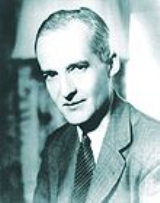
Luis Federico Leloir
Encyclopedia
Luis Federico Leloir was an Argentine
doctor
and biochemist
who received the 1970 Nobel Prize
in Chemistry. He was the first Spanish-speaking scientist to ever receive the award. Although born in France, Leloir received the majority of his education at the University of Buenos Aires
and was director of the private research group Fundación Instituto Campomar until his death in 1987. Although his laboratories were often plagued by lack of financial support and second-rate equipment, his research into sugar nucleotides, carbohydrate
metabolism, and renal hypertension
has garnered international attention and fame and has led to significant progress in understanding, diagnosing and treating the congenital disease galactosemia
. Luis Leloir is buried in La Recoleta Cemetery
, Buenos Aires
.
. After returning to Argentina in 1908, Leloir lived together with his eight siblings on their family's extensive property El Tuyú that his grandparents had purchased after their immigration from the Basque Country
of northern Spain
: El Tuyú comprises 400 km2 of rocky land that along the coastline from San Clemente del Tuyú
to Mar de Ajó
which has since become a popular tourist attraction.
During his childhood, the future Nobel Prize winner found himself observing natural phenomenon with particular interest; his schoolwork and readings highlighted the connections between the natural sciences and biology. His education was divided between Escuela General San Martín(primary school), Colegio Lacordaire(secondary school), and for a few months at Beaumont College
in England
. His grades were unspectacular, and his first stint in college ended quickly when he abandoned his architectural studies that he had begun in Paris' École Polytechnique
.
It was during the 1920s that Leloir invented salsa golf
(golf sauce). After being served prawns with the usual sauce during lunch with a group of friends at the Ocean Club in Mar del Plata, Leloir came up with a peculiar combination of ketchup and mayonnaise to spice up his meal. With the financial difficulties that later plagued Leloir's laboratories and research, he would joke, "If I had patented that sauce, we'd have a lot more money for research right now."
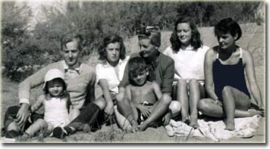 After returning again to Argentina
After returning again to Argentina
, Leloir obtained his Argentine citizenship and joined the Department of Medicine at the University of Buenos Aires
in hopes of receiving his doctorate. However, he got off to a rocky start, requiring four attempts to pass his anatomy exam. He finally received his diploma in 1932 and began his residency in the Hospital de Clínicas
and his medical internship in Ramos Mejía hospital. After some initial conflicts with colleagues and complications in his method of treating patients, Leloir decided to dedicate himself to research in the laboratory, claiming that "we could do little for our patients... antibiotics, psychoactive drugs, and all the new therapeutic agents were unknown [at the time]."
In 1933, he met Bernardo A. Houssay, who pointed Leloir towards investigating in his doctoral thesis the suprarenal glands and carbohydrate metabolism. Houssay happened to be friends with Carlos Bonorino Udaondo, the brother-in-law of Victoria Ocampo
, one of Leloir's cousins. Following the recommendation of Udaondo, Leloir began working with Houssay, who in 1947 would later win the Nobel Prize for Physiology or Medicine. The two would develop a close relationship, collaborating on various projects until Houssay's death in 1971; in his lecture after winning the Nobel Prize, Leloir claimed that his "whole research career has been influenced by one person, Prof. Bernardo A. Houssay".
, mathematics
, chemistry
, and biology
was lacking, he continued attending classes at the University as a part-time student. In 1936 he traveled to England to begin advanced studies at the University of Cambridge
, under the supervision of another Nobel Prize winner, Sir Frederick Gowland Hopkins, who had obtained that distinction in 1929 for his work in physiology
and in revealing the critical role of vitamins in maintaining good health. Leloir's research in the Biochemical Laboratory of Cambridge centered around enzymes, more specifically the effects of cyanide
and pyrophosphate
on succinic dehydrogenase; from this moment Leloir began to specialize in researching carbohydrate metabolism.
and the military government led by Pedro Pablo Ramírez
. Leloir fled to the United States
, where he assumed the position of associate professor in the Department of Pharmacology
at Washington University in St. Louis
, collaborating with Carl Cori and Gerty Cori
and thereafter worked with David E. Green
at the College of Pysicians and Surgeons, Columbia University
as a research assistant. Leloir would later credit Green with instilling within him the initiative to establish his own research group once back in Argentina.
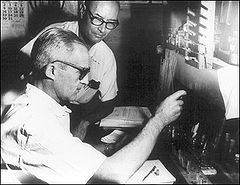 In 1945 Leloir ended his exile and returned to Argentina to work under Houssay at the Instituto de Investigaciones Bioquímicas de la Fundación Campomar
In 1945 Leloir ended his exile and returned to Argentina to work under Houssay at the Instituto de Investigaciones Bioquímicas de la Fundación Campomar
, which Leloir would direct from its creation in 1947 by businessman and patron Jaime Campomar. Initially, the institute was composed of five rooms, a bathroom, central hall, patio, kitchen, and changing room. During the final years of the 1940s, although lacking financial resources and operating with very low-cost teams, Leloir's successful experiments would reveal the chemical origins of sugar synthesis in yeast
as well as the oxidation of fatty acids in the liver; together with J. M. Muñoz, he produced an active cell-free system, a first in scientific research. It had initially been assumed that in order to study a cell, scientists could not separate it from its host organism, as oxidation could only occur in intact cells. Along the way, Muñoz and Leloir, unable to procure the costly centrifuge needed to separate cell contents, improvised by spinning a tire stuffed with salt and ice.
By 1947 he had formed a team that included Rawell Caputo, Enrico Cabib, Raúl Trucco, Alejandro Paladini, Carlos Cardini and José Luis Reissig, with whom he investigated and discovered why a malfunctioning kidney and angiotensin
helped cause hypertension. That same year, his colleague Rawell Caputo, in his investigations of the mammary gland
, made discoveries regarding carbohydrate storage and its subsequent transformation into a reserve energy form in organisms.
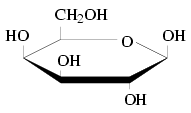 At the beginning of 1948, Leloir and his team identified the sugar nucleotides that were fundamental to the metabolism of carbohydrates, turning the Instituo Campomar into a biochemistry institution well-known throughout the world. Immediately thereafter, Leloir received the Argentine Scientific Society Prize, one of the many awards he would receive both in Argentina and internationally. During this time, his team dedicated itself to the study of glycoproteins; Leloir and his colleagues elucidated the primary mechanisms of galactose metabolism (now coined the Leloir pathway
At the beginning of 1948, Leloir and his team identified the sugar nucleotides that were fundamental to the metabolism of carbohydrates, turning the Instituo Campomar into a biochemistry institution well-known throughout the world. Immediately thereafter, Leloir received the Argentine Scientific Society Prize, one of the many awards he would receive both in Argentina and internationally. During this time, his team dedicated itself to the study of glycoproteins; Leloir and his colleagues elucidated the primary mechanisms of galactose metabolism (now coined the Leloir pathway
) and determined the cause of galactosemia, a serious genetic disorder
that resulted in lactose intolerance
.
The following year, he reached an agreement with Roland Garcia, dean of the Department of Natural Sciences at UBA, which named Leloir, Carlos Eugenio Cardini and Enrico Cabib as titular professors in the University's newly founded Biochemical Institute. The Institute would help develop scientific programs in budding Argentinian universities as well as attract researchers and scholars from the United States, Japan
, England, France, Spain, and other Latin American countries.
Following Campomar's death in 1957, Leloir and his team applied to the National Institutes of Health
in the United States desperate for funding, and surprisingly was accepted. In 1958, the Institute found a new home in a former all-girls school, a donation from the Argentine government. As Leloir and his research gained greater prominence, further research came from the Argentine Research Council, and the Institute would later become associated with the University of Buenos Aires.
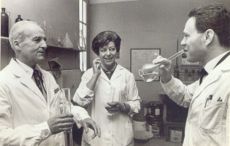 As his work in the laboratory was coming to an end, Leloir continued his teaching position in the Department of Natural Sciences at the University of Buenos Aires, taking a hiatus only to complete his studies at Cambridge and at the Enzyme Research Laboratory in the United States.
As his work in the laboratory was coming to an end, Leloir continued his teaching position in the Department of Natural Sciences at the University of Buenos Aires, taking a hiatus only to complete his studies at Cambridge and at the Enzyme Research Laboratory in the United States.
In 1983, Leloir became one of the founding members of the Third World Academy of Sciences
.
for his discovery of the metabolic pathways in lactose, becoming only the third Argentine to receive the prestigious honor in any field. In his acceptance speech at Stockholm
, he borrowed Winston Churchill
's famous 1940 speech to the House of Commons
and remarked, "never have I received so much for so little". Leloir and his team reportedly celebrated by drinking champagne from test tubes, a rare departure from the humbleness and frugality that characterized the atmosphere of Fundación Instituto Campomar under Leloir's direction. The $80,000 prize money was spent directly on research, and when asked about the significance of his achievement, Leloir humbly responded:
's novels that depicted the country wildlife and scenery of Leloir's childhood.
He died in Buenos Aires December 2, 1987 of a heart attack soon after returning to his home from the laboratory, and is buried in La Recoleta Cemetery
. Mario Bunge
, a friend and colleague of Leloir, claims that his lasting legacy was proving that "scientific research on an international level, although precarious, was possible in an underdeveloped country in the middle of political strife" and credits Leloir's vigilance and will for his ultimate success. With his research in dire financial straits, Leloir often resorted to homemade gadgets and contraptions to continue his work in the laboratory. In one instance, Leloir reportedly used waterproof cardboard to create makeshift gutters in order to protect his laboratory's library from the rain.
Leloir was known for his humbleness, focus and consistency, described by many as a "true monk in science". Every morning his wife Amelia would drive him in their Fiat 600
and drop him off at 1719 Julián Alvarez Street, location of Fundación Instituto Campomar, with Leloir wearing the same worn out, gray overalls. He worked sitting on the same straw seat for decades and encouraged colleagues to eat lunch in the laboratory to save time, bringing enough meat stew to share with everyone. Indeed, despite Leloir's frugality and extreme dedication to his research, he was a sociable man, claiming not to like working alone.
The Fundación Instituto Campomar has since been renamed Fundación Instituto Leloir
, and has grown to become a 21000 sq ft (1,951 m²) building with 20 senior researchers, 42 technicians and administrative personnel, 8 post doctorate fellows, and 20 Ph.D. candidates. The Institute conducts research in a variety of fields, including Alzheimer's disease
, Parkinson's disease
, and multiple sclerosis
.
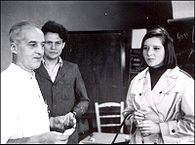
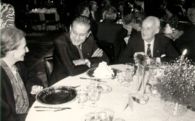
Argentina
Argentina , officially the Argentine Republic , is the second largest country in South America by land area, after Brazil. It is constituted as a federation of 23 provinces and an autonomous city, Buenos Aires...
doctor
Physician
A physician is a health care provider who practices the profession of medicine, which is concerned with promoting, maintaining or restoring human health through the study, diagnosis, and treatment of disease, injury and other physical and mental impairments...
and biochemist
Biochemistry
Biochemistry, sometimes called biological chemistry, is the study of chemical processes in living organisms, including, but not limited to, living matter. Biochemistry governs all living organisms and living processes...
who received the 1970 Nobel Prize
Nobel Prize
The Nobel Prizes are annual international awards bestowed by Scandinavian committees in recognition of cultural and scientific advances. The will of the Swedish chemist Alfred Nobel, the inventor of dynamite, established the prizes in 1895...
in Chemistry. He was the first Spanish-speaking scientist to ever receive the award. Although born in France, Leloir received the majority of his education at the University of Buenos Aires
University of Buenos Aires
The University of Buenos Aires is the largest university in Argentina and the largest university by enrollment in Latin America. Founded on August 12, 1821 in the city of Buenos Aires, it consists of 13 faculties, 6 hospitals, 10 museums and is linked to 4 high schools: Colegio Nacional de Buenos...
and was director of the private research group Fundación Instituto Campomar until his death in 1987. Although his laboratories were often plagued by lack of financial support and second-rate equipment, his research into sugar nucleotides, carbohydrate
Carbohydrate
A carbohydrate is an organic compound with the empirical formula ; that is, consists only of carbon, hydrogen, and oxygen, with a hydrogen:oxygen atom ratio of 2:1 . However, there are exceptions to this. One common example would be deoxyribose, a component of DNA, which has the empirical...
metabolism, and renal hypertension
Hypertension
Hypertension or high blood pressure is a cardiac chronic medical condition in which the systemic arterial blood pressure is elevated. What that means is that the heart is having to work harder than it should to pump the blood around the body. Blood pressure involves two measurements, systolic and...
has garnered international attention and fame and has led to significant progress in understanding, diagnosing and treating the congenital disease galactosemia
Galactosemia
Galactosemia is a rare genetic metabolic disorder that affects an individual's ability to metabolize the sugar galactose properly. Although the sugar lactose can metabolize to galactose, galactosemia is not related to and should not be confused with lactose intolerance...
. Luis Leloir is buried in La Recoleta Cemetery
La Recoleta Cemetery
La Recoleta Cemetery is a famous cemetery located in the exclusive Recoleta neighbourhood of Buenos Aires, Argentina. It contains the graves of notable people, including Eva Perón, Raúl Alfonsín, and several presidents of Argentina.- History :...
, Buenos Aires
Buenos Aires
Buenos Aires is the capital and largest city of Argentina, and the second-largest metropolitan area in South America, after São Paulo. It is located on the western shore of the estuary of the Río de la Plata, on the southeastern coast of the South American continent...
.
Early years
Leloir's parents, Federico Leloir and Hortensia Aguirre de Leloir, traveled from Buenos Aires to Paris in the middle of 1906 with the intention of treating Federico's illness. However, Federico died in late August, and a week later Luis was born in an old house at 81 Víctor Hugo Road in Paris, a few blocks away from the Arc de TriompheArc de Triomphe
-The design:The astylar design is by Jean Chalgrin , in the Neoclassical version of ancient Roman architecture . Major academic sculptors of France are represented in the sculpture of the Arc de Triomphe: Jean-Pierre Cortot; François Rude; Antoine Étex; James Pradier and Philippe Joseph Henri Lemaire...
. After returning to Argentina in 1908, Leloir lived together with his eight siblings on their family's extensive property El Tuyú that his grandparents had purchased after their immigration from the Basque Country
Basque Country (historical territory)
The Basque Country is the name given to the home of the Basque people in the western Pyrenees that spans the border between France and Spain on the Atlantic coast....
of northern Spain
Spain
Spain , officially the Kingdom of Spain languages]] under the European Charter for Regional or Minority Languages. In each of these, Spain's official name is as follows:;;;;;;), is a country and member state of the European Union located in southwestern Europe on the Iberian Peninsula...
: El Tuyú comprises 400 km2 of rocky land that along the coastline from San Clemente del Tuyú
San Clemente del Tuyú
San Clemente del Tuyú is an Argentine town in the Partido de la Costa district of the Province of Buenos Aires.-History:Noticed by Ferdinand Magellan in 1520, who gave nearby Cape San Antonio its name, Spanish authorities first surveyed the area in 1580...
to Mar de Ajó
Mar de Ajó
Mar de Ajó is a coastal city in Buenos Aires Province, Argentina, and is located in the southern end of the seaside La Costa Partido .-History and overview:...
which has since become a popular tourist attraction.
During his childhood, the future Nobel Prize winner found himself observing natural phenomenon with particular interest; his schoolwork and readings highlighted the connections between the natural sciences and biology. His education was divided between Escuela General San Martín(primary school), Colegio Lacordaire(secondary school), and for a few months at Beaumont College
Beaumont College
Beaumont College was a Jesuit public school in Old Windsor, Berkshire, England. In 1967 the school closed. The property became a conference centre, and from 2008 an hotel.-History of the estate:...
in England
England
England is a country that is part of the United Kingdom. It shares land borders with Scotland to the north and Wales to the west; the Irish Sea is to the north west, the Celtic Sea to the south west, with the North Sea to the east and the English Channel to the south separating it from continental...
. His grades were unspectacular, and his first stint in college ended quickly when he abandoned his architectural studies that he had begun in Paris' École Polytechnique
École Polytechnique
The École Polytechnique is a state-run institution of higher education and research in Palaiseau, Essonne, France, near Paris. Polytechnique is renowned for its four year undergraduate/graduate Master's program...
.
It was during the 1920s that Leloir invented salsa golf
Salsa golf
Salsa golf is a cold sauce of somewhat thick consistency, common in Argentina. According to legend, it was invented by Nobel laureate Luis Federico Leloir in the mid-1920s at the "Golf Club" at the seaside resort Mar del Plata...
(golf sauce). After being served prawns with the usual sauce during lunch with a group of friends at the Ocean Club in Mar del Plata, Leloir came up with a peculiar combination of ketchup and mayonnaise to spice up his meal. With the financial difficulties that later plagued Leloir's laboratories and research, he would joke, "If I had patented that sauce, we'd have a lot more money for research right now."
Buenos Aires

Argentina
Argentina , officially the Argentine Republic , is the second largest country in South America by land area, after Brazil. It is constituted as a federation of 23 provinces and an autonomous city, Buenos Aires...
, Leloir obtained his Argentine citizenship and joined the Department of Medicine at the University of Buenos Aires
University of Buenos Aires
The University of Buenos Aires is the largest university in Argentina and the largest university by enrollment in Latin America. Founded on August 12, 1821 in the city of Buenos Aires, it consists of 13 faculties, 6 hospitals, 10 museums and is linked to 4 high schools: Colegio Nacional de Buenos...
in hopes of receiving his doctorate. However, he got off to a rocky start, requiring four attempts to pass his anatomy exam. He finally received his diploma in 1932 and began his residency in the Hospital de Clínicas
Hospital de Clínicas "José de San Martín"
The Hospital de Clínicas "José de San Martín" is a teaching hospital located in Buenos Aires, Argentina. It belongs to the University of Buenos Aires , currently the best ranked university in that country.-History:...
and his medical internship in Ramos Mejía hospital. After some initial conflicts with colleagues and complications in his method of treating patients, Leloir decided to dedicate himself to research in the laboratory, claiming that "we could do little for our patients... antibiotics, psychoactive drugs, and all the new therapeutic agents were unknown [at the time]."
In 1933, he met Bernardo A. Houssay, who pointed Leloir towards investigating in his doctoral thesis the suprarenal glands and carbohydrate metabolism. Houssay happened to be friends with Carlos Bonorino Udaondo, the brother-in-law of Victoria Ocampo
Victoria Ocampo
Victoria Ocampo Aguirre was an Argentine writer and intellectual, described by Jorge Luis Borges as La mujer más argentina ....
, one of Leloir's cousins. Following the recommendation of Udaondo, Leloir began working with Houssay, who in 1947 would later win the Nobel Prize for Physiology or Medicine. The two would develop a close relationship, collaborating on various projects until Houssay's death in 1971; in his lecture after winning the Nobel Prize, Leloir claimed that his "whole research career has been influenced by one person, Prof. Bernardo A. Houssay".
Cambridge
After only two years, Leloir received recognition from the medical department at UBA for having produced the best doctoral thesis. Feeling that his knowledge in fields such as physicsPhysics
Physics is a natural science that involves the study of matter and its motion through spacetime, along with related concepts such as energy and force. More broadly, it is the general analysis of nature, conducted in order to understand how the universe behaves.Physics is one of the oldest academic...
, mathematics
Mathematics
Mathematics is the study of quantity, space, structure, and change. Mathematicians seek out patterns and formulate new conjectures. Mathematicians resolve the truth or falsity of conjectures by mathematical proofs, which are arguments sufficient to convince other mathematicians of their validity...
, chemistry
Chemistry
Chemistry is the science of matter, especially its chemical reactions, but also its composition, structure and properties. Chemistry is concerned with atoms and their interactions with other atoms, and particularly with the properties of chemical bonds....
, and biology
Biology
Biology is a natural science concerned with the study of life and living organisms, including their structure, function, growth, origin, evolution, distribution, and taxonomy. Biology is a vast subject containing many subdivisions, topics, and disciplines...
was lacking, he continued attending classes at the University as a part-time student. In 1936 he traveled to England to begin advanced studies at the University of Cambridge
University of Cambridge
The University of Cambridge is a public research university located in Cambridge, United Kingdom. It is the second-oldest university in both the United Kingdom and the English-speaking world , and the seventh-oldest globally...
, under the supervision of another Nobel Prize winner, Sir Frederick Gowland Hopkins, who had obtained that distinction in 1929 for his work in physiology
Physiology
Physiology is the science of the function of living systems. This includes how organisms, organ systems, organs, cells, and bio-molecules carry out the chemical or physical functions that exist in a living system. The highest honor awarded in physiology is the Nobel Prize in Physiology or...
and in revealing the critical role of vitamins in maintaining good health. Leloir's research in the Biochemical Laboratory of Cambridge centered around enzymes, more specifically the effects of cyanide
Cyanide
A cyanide is a chemical compound that contains the cyano group, -C≡N, which consists of a carbon atom triple-bonded to a nitrogen atom. Cyanides most commonly refer to salts of the anion CN−. Most cyanides are highly toxic....
and pyrophosphate
Pyrophosphate
In chemistry, the anion, the salts, and the esters of pyrophosphoric acid are called pyrophosphates. Any salt or ester containing two phosphate groups is called a diphosphate. As a food additive, diphosphates are known as E450.- Chemistry :...
on succinic dehydrogenase; from this moment Leloir began to specialize in researching carbohydrate metabolism.
United States
Leloir returned to Buenos Aires in 1937 after his brief stay at Cambridge. 1943 saw Leloir marry; Luis Leloir and Amelia Zuberbuhler would later have a daughter also named Amelia. However, his return to Argentina was amidst conflict and strife; Houssay had been expelled from the University of Buenos Aires for signing a public petition opposing the fascist Nazi regime in GermanyGermany
Germany , officially the Federal Republic of Germany , is a federal parliamentary republic in Europe. The country consists of 16 states while the capital and largest city is Berlin. Germany covers an area of 357,021 km2 and has a largely temperate seasonal climate...
and the military government led by Pedro Pablo Ramírez
Pedro Pablo Ramírez
General Pedro Pablo Ramírez was de facto President of Argentina from June 7, 1943 to February 24, 1944. He was the founder and leader of the Guardia Nacional, Argentina's Fascist militia....
. Leloir fled to the United States
United States
The United States of America is a federal constitutional republic comprising fifty states and a federal district...
, where he assumed the position of associate professor in the Department of Pharmacology
Pharmacology
Pharmacology is the branch of medicine and biology concerned with the study of drug action. More specifically, it is the study of the interactions that occur between a living organism and chemicals that affect normal or abnormal biochemical function...
at Washington University in St. Louis
Washington University in St. Louis
Washington University in St. Louis is a private research university located in suburban St. Louis, Missouri. Founded in 1853, and named for George Washington, the university has students and faculty from all fifty U.S. states and more than 110 nations...
, collaborating with Carl Cori and Gerty Cori
Gerty Cori
Gerty Theresa Cori was an American biochemist who became the third woman—and first American woman—to win a Nobel Prize in science, and the first woman to be awarded the Nobel Prize in Physiology or Medicine.Cori was born in Prague...
and thereafter worked with David E. Green
David E. Green
David Ezra Green was an America biochemist who made significant contributions to the study of enzymes, particularly the electron transport chain and oxidative phosphorylation. He was born in New York and was awarded a degree in biology from New York University...
at the College of Pysicians and Surgeons, Columbia University
Columbia University
Columbia University in the City of New York is a private, Ivy League university in Manhattan, New York City. Columbia is the oldest institution of higher learning in the state of New York, the fifth oldest in the United States, and one of the country's nine Colonial Colleges founded before the...
as a research assistant. Leloir would later credit Green with instilling within him the initiative to establish his own research group once back in Argentina.
Fundación Instituto Campomar

Leloir Institute
The Leloir Institute is a non-profit research center in Buenos Aires specializing in biotechnology, including biochemistry, cellular biology, molecular biology, and related activities.-Overview:...
, which Leloir would direct from its creation in 1947 by businessman and patron Jaime Campomar. Initially, the institute was composed of five rooms, a bathroom, central hall, patio, kitchen, and changing room. During the final years of the 1940s, although lacking financial resources and operating with very low-cost teams, Leloir's successful experiments would reveal the chemical origins of sugar synthesis in yeast
Yeast
Yeasts are eukaryotic micro-organisms classified in the kingdom Fungi, with 1,500 species currently described estimated to be only 1% of all fungal species. Most reproduce asexually by mitosis, and many do so by an asymmetric division process called budding...
as well as the oxidation of fatty acids in the liver; together with J. M. Muñoz, he produced an active cell-free system, a first in scientific research. It had initially been assumed that in order to study a cell, scientists could not separate it from its host organism, as oxidation could only occur in intact cells. Along the way, Muñoz and Leloir, unable to procure the costly centrifuge needed to separate cell contents, improvised by spinning a tire stuffed with salt and ice.
By 1947 he had formed a team that included Rawell Caputo, Enrico Cabib, Raúl Trucco, Alejandro Paladini, Carlos Cardini and José Luis Reissig, with whom he investigated and discovered why a malfunctioning kidney and angiotensin
Angiotensin
Angiotensin, a peptide hormone, causes blood vessels to constrict, and drives blood pressure up. It is part of the renin-angiotensin system, which is a major target for drugs that lower blood pressure. Angiotensin also stimulates the release of aldosterone, another hormone, from the adrenal cortex...
helped cause hypertension. That same year, his colleague Rawell Caputo, in his investigations of the mammary gland
Mammary gland
A mammary gland is an organ in mammals that produces milk to feed young offspring. Mammals get their name from the word "mammary". In ruminants such as cows, goats, and deer, the mammary glands are contained in their udders...
, made discoveries regarding carbohydrate storage and its subsequent transformation into a reserve energy form in organisms.
Sugar nucleotides

Leloir pathway
The Leloir pathway is a metabolic pathway for the catabolism of D-galactose. It is named after Luis Federico Leloir.In the first step α-D-galactose is phosphorylated by a kinase to galactose 1-phosphate. Also part of this pathway is a mutarotase that facilitates the conversion of β-D-galactose to...
) and determined the cause of galactosemia, a serious genetic disorder
Genetic disorder
A genetic disorder is an illness caused by abnormalities in genes or chromosomes, especially a condition that is present from before birth. Most genetic disorders are quite rare and affect one person in every several thousands or millions....
that resulted in lactose intolerance
Lactose intolerance
Lactose intolerance, also called lactase deficiency or hypolactasia, is the inability to digest and metabolize lactose, a sugar found in milk...
.
The following year, he reached an agreement with Roland Garcia, dean of the Department of Natural Sciences at UBA, which named Leloir, Carlos Eugenio Cardini and Enrico Cabib as titular professors in the University's newly founded Biochemical Institute. The Institute would help develop scientific programs in budding Argentinian universities as well as attract researchers and scholars from the United States, Japan
Japan
Japan is an island nation in East Asia. Located in the Pacific Ocean, it lies to the east of the Sea of Japan, China, North Korea, South Korea and Russia, stretching from the Sea of Okhotsk in the north to the East China Sea and Taiwan in the south...
, England, France, Spain, and other Latin American countries.
Following Campomar's death in 1957, Leloir and his team applied to the National Institutes of Health
National Institutes of Health
The National Institutes of Health are an agency of the United States Department of Health and Human Services and are the primary agency of the United States government responsible for biomedical and health-related research. Its science and engineering counterpart is the National Science Foundation...
in the United States desperate for funding, and surprisingly was accepted. In 1958, the Institute found a new home in a former all-girls school, a donation from the Argentine government. As Leloir and his research gained greater prominence, further research came from the Argentine Research Council, and the Institute would later become associated with the University of Buenos Aires.
Later years

In 1983, Leloir became one of the founding members of the Third World Academy of Sciences
Third World Academy of Sciences
TWAS, until 2004 named Third World Academy of Sciences and now TWAS, the academy of sciences for the developing world, is a merit-based science academy uniting 1,000 scientists in some 70 countries. Its principal aim is to promote scientific capacity and excellence for sustainable development in...
.
Nobel Prize
On December 2, 1970, Leloir received the Nobel Prize for Chemistry from the King of SwedenSweden
Sweden , officially the Kingdom of Sweden , is a Nordic country on the Scandinavian Peninsula in Northern Europe. Sweden borders with Norway and Finland and is connected to Denmark by a bridge-tunnel across the Öresund....
for his discovery of the metabolic pathways in lactose, becoming only the third Argentine to receive the prestigious honor in any field. In his acceptance speech at Stockholm
Stockholm
Stockholm is the capital and the largest city of Sweden and constitutes the most populated urban area in Scandinavia. Stockholm is the most populous city in Sweden, with a population of 851,155 in the municipality , 1.37 million in the urban area , and around 2.1 million in the metropolitan area...
, he borrowed Winston Churchill
Winston Churchill
Sir Winston Leonard Spencer-Churchill, was a predominantly Conservative British politician and statesman known for his leadership of the United Kingdom during the Second World War. He is widely regarded as one of the greatest wartime leaders of the century and served as Prime Minister twice...
's famous 1940 speech to the House of Commons
British House of Commons
The House of Commons is the lower house of the Parliament of the United Kingdom, which also comprises the Sovereign and the House of Lords . Both Commons and Lords meet in the Palace of Westminster. The Commons is a democratically elected body, consisting of 650 members , who are known as Members...
and remarked, "never have I received so much for so little". Leloir and his team reportedly celebrated by drinking champagne from test tubes, a rare departure from the humbleness and frugality that characterized the atmosphere of Fundación Instituto Campomar under Leloir's direction. The $80,000 prize money was spent directly on research, and when asked about the significance of his achievement, Leloir humbly responded:
Legacy
Leloir published a short autobiography, entitled "Long Ago and Far Away" in the 1983 Annual Review of Biochemistry. The title, Leloir claims, is derived from one of William Henry HudsonWilliam Henry Hudson
William Henry Hudson was an author, naturalist, and ornithologist.- Life and work :Hudson was born in the Quilmes, a borough of the greater Buenos Aires, in Buenos Aires Province, Argentina, son of settlers of U.S. origin...
's novels that depicted the country wildlife and scenery of Leloir's childhood.
He died in Buenos Aires December 2, 1987 of a heart attack soon after returning to his home from the laboratory, and is buried in La Recoleta Cemetery
La Recoleta Cemetery
La Recoleta Cemetery is a famous cemetery located in the exclusive Recoleta neighbourhood of Buenos Aires, Argentina. It contains the graves of notable people, including Eva Perón, Raúl Alfonsín, and several presidents of Argentina.- History :...
. Mario Bunge
Mario Bunge
Mario Augusto Bunge is an Argentine philosopher and physicist mainly active in Canada.-Biography:Bunge began his studies at the National University of La Plata, graduating with a Ph.D. in physico-mathematical sciences in 1952. He was professor of theoretical physics and philosophy,...
, a friend and colleague of Leloir, claims that his lasting legacy was proving that "scientific research on an international level, although precarious, was possible in an underdeveloped country in the middle of political strife" and credits Leloir's vigilance and will for his ultimate success. With his research in dire financial straits, Leloir often resorted to homemade gadgets and contraptions to continue his work in the laboratory. In one instance, Leloir reportedly used waterproof cardboard to create makeshift gutters in order to protect his laboratory's library from the rain.
Leloir was known for his humbleness, focus and consistency, described by many as a "true monk in science". Every morning his wife Amelia would drive him in their Fiat 600
Fiat 600
The Fiat 600 is a city car produced by the Italian automaker Fiat from 1955 to 1969. Measuring only 3.22 m long, it was the first rear-engined Fiat and cost the equivalent of about € 6,700 or US$ 7300 in today's money . The total number produced from 1955 to 1969 at the Mirafiori...
and drop him off at 1719 Julián Alvarez Street, location of Fundación Instituto Campomar, with Leloir wearing the same worn out, gray overalls. He worked sitting on the same straw seat for decades and encouraged colleagues to eat lunch in the laboratory to save time, bringing enough meat stew to share with everyone. Indeed, despite Leloir's frugality and extreme dedication to his research, he was a sociable man, claiming not to like working alone.
The Fundación Instituto Campomar has since been renamed Fundación Instituto Leloir
Leloir Institute
The Leloir Institute is a non-profit research center in Buenos Aires specializing in biotechnology, including biochemistry, cellular biology, molecular biology, and related activities.-Overview:...
, and has grown to become a 21000 sq ft (1,951 m²) building with 20 senior researchers, 42 technicians and administrative personnel, 8 post doctorate fellows, and 20 Ph.D. candidates. The Institute conducts research in a variety of fields, including Alzheimer's disease
Alzheimer's disease
Alzheimer's disease also known in medical literature as Alzheimer disease is the most common form of dementia. There is no cure for the disease, which worsens as it progresses, and eventually leads to death...
, Parkinson's disease
Parkinson's disease
Parkinson's disease is a degenerative disorder of the central nervous system...
, and multiple sclerosis
Multiple sclerosis
Multiple sclerosis is an inflammatory disease in which the fatty myelin sheaths around the axons of the brain and spinal cord are damaged, leading to demyelination and scarring as well as a broad spectrum of signs and symptoms...
.
Awards and distinctions


| Year | Distinction |
|---|---|
| 1943 | Third National Science Award |
| 1958 | T. Ducett Jones Memorial Award |
| 1965 | Bunge and Born Foundation Award |
| 1966 | Gairdner Foundation Award |
| 1967 | Columbia University Columbia University Columbia University in the City of New York is a private, Ivy League university in Manhattan, New York City. Columbia is the oldest institution of higher learning in the state of New York, the fifth oldest in the United States, and one of the country's nine Colonial Colleges founded before the... 's Louisa Gross Horwitz Prize Louisa Gross Horwitz Prize Louisa Gross Horwitz Prize for Biology or Biochemistry is an annual prize awarded by Columbia University to a researcher or group of researchers that have made an outstanding contribution in basic research in the fields of biology or biochemistry.... |
| 1968 | Benito Juárez Award |
| 1968 | Honorary Doctorate from Universidad Nacional de Córdoba |
| 1968 | Argentina Chemistry Association's José Jolly Kyle Award |
| 1969 | Honorary member of the English Biochemical Society |
| 1970 | Nobel Prize in Chemistry Nobel Prize in Chemistry The Nobel Prize in Chemistry is awarded annually by the Royal Swedish Academy of Sciences to scientists in the various fields of chemistry. It is one of the five Nobel Prizes established by the will of Alfred Nobel in 1895, awarded for outstanding contributions in chemistry, physics, literature,... |
| 1971 | Legion de Honor “Orden de Andrés Bello” |
| 1976 | Bernardo O'Higgins en el Grado de Gran Cruz |
| 1982 | French Legion of Honor |
Published works
- "Suprarrenales y Metabolismo de los hidratos de carbono", (1934)
- "Farmacología de la hipertensina", (1940)
- "Hipertensión arterial nefrógena, (1943)
- "Perspectives in Biology", (1963)
- "Renal Hipertensión", (1964)
- "In Vitro Synthesis of Particulate Glycogen", (1965)
- "Properties of Synthetic and Native liver Glycogen", (1967)
- "Faraway and Long ago", (1983)
- "Lipid-bond Saccharides containing glucose and galactose in agrobacterium tumefaciens", (1984)
- "An Intermediail in Cyclic 1-2 Glucan Biosynthesis", (1985)
- "Structural correspondence between an oligosaccharide bound to a lipid with the repeating unit of the Rhizobium meliloti" (M. E. Tolmasky, R. J. Staneloni, and L. F. Leloir), Anales de la Asociación Química Argentina (1982) no.70 pg.833-842.
- "N-glycosilation of the proteins" (M. E. Tolmasky, H. K. Takahashi, R. J. Staneloni, and L. F. Leloir), Anales de la Asociación Química Argentina (1982) no.70 pg.405-411.
- "Transfer of oligosaccharide to protein from a lipid intermediate in plants" (R. J. Staneloni, M. E. Tolmasky, C. Petriella, and L. F. Leloir), Plant Physiology (1981) no.68 pg.1175-1179.
- "Presence in a plant of a compound similar to the dolichyl diphosphate oligosaccharide of animal tissue" (R. J. Staneloni, M. E. Tolmasky, C. Petriella, R. A. Ugalde, and L. F. Leloir), Biochemical Journal (1980) no.191 pg.257-260.
- "Lipid bound sugars in Rhizobium meliloti" (M. E. Tolmasky, R. J. Staneloni , R. A. Ugalde, and L. F. Leloir), Archives of Biochemistry and Biophysics (1980) no.203 pg.358-364.

